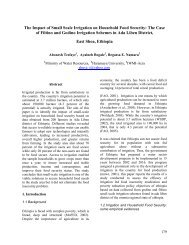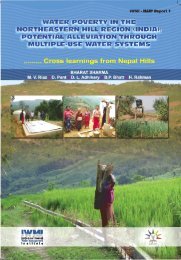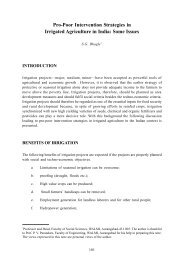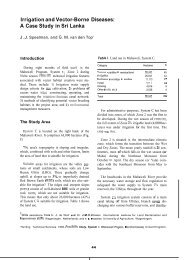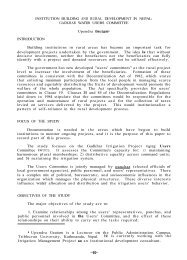A Case Study from System H, Sri Lanka
A Case Study from System H, Sri Lanka
A Case Study from System H, Sri Lanka
- No tags were found...
Create successful ePaper yourself
Turn your PDF publications into a flip-book with our unique Google optimized e-Paper software.
CHAPTER IIntroductionRECENT HISTORICAL BACKGROUND OF SETTLEMENTS IN SRI LANKATHE MANAGEm OF settlement projects has traditionally been the responsibility of district adminisaation in which theGovernment Agent played the coordinating role on behalf of a number of minishies and departments relating toagriculture, irrigation, land administration, and settler services: These ministries and departments launched the initialphase of settlement in the Dry Zone. When the next phase of settlement was put into operation, the management systemwas modified, and the Gal Oya Development Board (GODB), the River Valleys Development Board (RVDB), and theMahaweli Development Board (MDB). were constituted as Statutory Boards responsible for integrated multipurpose.development functions in the areas demarcated for the Gal Oya Scheme, the Uda Walawe Scheme, and <strong>System</strong> H of theMahaweli Development Programme, respectively. These areas have teen managed as separate adminisaative systemsoutside the district administration. The Mahaweli Authority of <strong>Sri</strong> <strong>Lanka</strong> WSL), which was set up in 1979, may beconsidered as an improvement on previous organizations involved in settlement management, because its administrationsystem, sIructure, and character are more flexible and results-oriented than those of the two earlier organizations.When the Mahaweli Development Board was set up to carry out integrated development of <strong>System</strong> H in the 19708,the project organization was placed under a Resident Project Manager who was responsible for the entire physical,economic, and social development of the project. TheResidentProject Manager, however, had toobtain the cooperationof several other agencies, such as the Department of Agriculture (DA) for agricultural extension work, the GovernmentAgent (GA) for statutory activities, and the Department of Agrarian Services @AS) for work relating to farmer organizations.The Resident Project Manager still had to work with a multitude of departmental officers at the field level, andtherefore the system was only a slight improvement on the earlier one.INTEGRATED SYSTEM OF MANAGEMENT IN AREAS UNDER THE MASLIn 1979. when the Mahaweli Authority of <strong>Sri</strong><strong>Lanka</strong> (MASL) tookoverresponsibility, aunifiedmanagementmcdel wasestablished with the Resident Project Manager, the block manager, and the unit manager being responsible for anintegrated management system at three different levels on a temtotial division of work similar to the district, divisionand village levels of the traditional administrative system pigwe 1). The unit manager was responsible for a settlementarea constituting about 200-250 families in respect of all activities connected with settlement management in the area.As the single multifunctional officer at the base level he was to function as the direct link between the settlers and themanagement.The black manager was responsible for a settlement area occupied by 2,000-2.500 families. The block was dividedinto several units. and the manager was assisted by specialist functionaries in areas such as agriculture, irrigation, landadministration, community development, and marketing. The Resident Project Manager was responsible forasettlementareaconsisting of about 6,000-10.000 families divided into a number of blocks. He was assisted by several project-levelfunctionaries in the same specialist areas as at the block level.A high degree of coordination and cooperation was envisaged under this arrangement since. it was an improvementon the original dishict administration system, and because all the personnel involved in these territorial and functionalactivities were under the supervision of the Resident Project Manager as direct employees of the MASL.1



